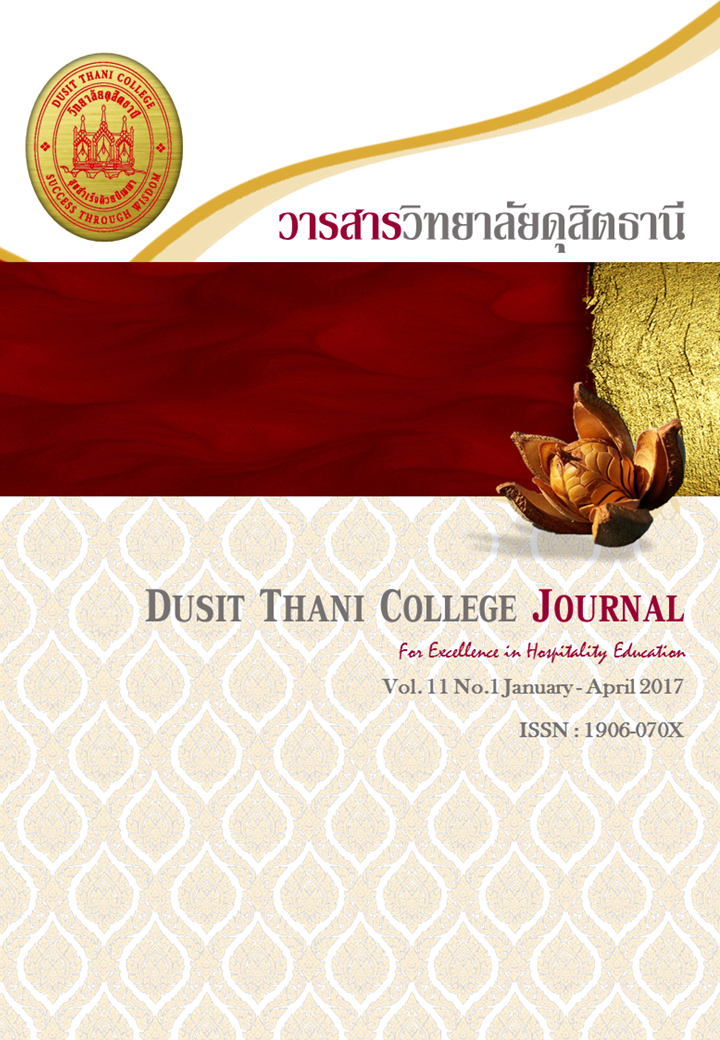Strategies for Enhancing Creative Culture in Thai Higher Education Institutions
Main Article Content
Abstract
The objectives of this research were: 1) To study and to synthesize the elements of creative culture in higher education institutions, 2) to analyze the need for a creative culture in Thai higher education institutions, and 3) to develop strategies for enhancing a creative culture in Thai higher education institutions. The samples were as follows: 1) Executives of Thai higher education institutions, academics, and the executives of creative organizations, 2) the executives of creative industry departments, 3) the instructors of creative industry departments, 4) the personnel of creative industry departments, and 5) students in the fourth year of creative industry departments. The research instruments comprised of an interview, and questionnaires. Data were analyzed through descriptive statistics, and PNImodified technique. The results of the study showed that there were seven elements of creative culture in higher education institutions: 1) Creative policies and goals, 2) creative environment, 3) creative organizational structure, 4) creative supporting system, 5) creative human resource management, 6) creative leadership, and 7) creative behavior and attitude of people in the institutions. The strategies for enhancing creative culture in Thai higher education institutions contained 5 main strategies were: 1) Specify the policy and target of cultural support in the university 2) develop the creative environments of all its dimensions, 3) develop and support the concept of innovation as it relates to intellectual property, 4) change the leader paradigm and organization’s construction, and 5) talent management toward creativity and innovation.
Article Details
Article Screening Policy
- All research and academic articles to be published must be considered and screened by three peer reviews in the relevant field / article.
- All articles, texts, illustrations and tables published in the journal are the personal opinions of the authors. Editors don't always have to agree. And no responsibility whatsoever is the sole responsibility of the author.
- The articles to be published must never be published. Where did you first publish? And not in the consideration of other journals If the audit found that there has been a duplicate publication It is the sole responsibility of the author.
- Any article that the reader sees as being plagiarized or impersonated without reference. Or mislead the work of the author Please let the journal editor know it will be your greatest blessing.
References
ณิชา ฉิมทองดี. (2557). กลยุทธ์การบริหารโรงเรียนเพื่อสร้างนวัตกรรมการจัดการเรียนรู้. วิทยานิพนธ์ (ค.ด.) จุฬาลงกรณ์มหาวิทยาลัย.
ดนัย เทียนพุฒ. (2552). คิดไทยสไตล์โมเดิร์น [Online]. เข้าถึงได้จาก http://www.itedonline.net/itedaffi/index.php [8 กุมภาพันธ์ 2555]
ฐิติกร พูลภัทรชีวิน. (2553). เศรษฐกิจสร้างสรรค์ [Online]. เข้าถึงได้จาก https://sites.google.com/site/gaiusjustthink/thitikorn-on-design [3 มกราคม 2555]
ธวัช บุณยมณี. (2550). ภาวะผู้นำและการเปลี่ยนแปลง. กรุงเทพมหานคร: โอเดียนสโตร์.
นัทธี จิตสว่าง. (2554). จาก Knowledge Management สู่องค์กรนวัตกรรม [Online]. เข้าถึงได้จาก http://www.correct.go.th/temp_image/km.htm [27 มกราคม 2555]
พัชมน อันโต. (2546). ความสัมพันธ์ระหว่างปัจจัยส่วนบุคคล แรงจูงใจใฝ่สัมฤทธิ์ในการสร้างนวัตกรรมขององค์กร กับการปฏิบัติงานของพยาบาลวิชาชีพ โรงพยาบาลของรัฐ เขตกรุงเทพมหานคร. วิทยานิพนธ์ (พย.ม.) จุฬาลงกรณ์มหาวิทยาลัย
วีรายา อักกะโชติกุล. (2552). การวิเคราะห์กระบวนการพัฒนานวัตกรรมการเรียนการสอนของครู โดยใช้เทคนิคการสืบสอบแบบชื่นชม. วิทยานิพนธ์ (ค.ม.). จุฬาลงกรณ์มหาวิทยาลัย
สมบัติ กุสุมาวลี. (2552). พัฒนาคนและองค์การในยุคเศรษฐกิจสร้างสรรค์. เอกสารอัดสำเนา.
สำนักงานคณะกรรมการการพัฒนาเศรษฐกิจและสังคมแห่งชาติ. (2554). แผนพัฒนาเศรษฐกิจและสังคมแห่งชาติ ฉบับที่ 11 พ.ศ.2555-2559. กรุงเทพฯ: สูตรไพศาล.
อลงกรณ์ พลบุตร. (2554). นโยบายเศรษฐกิจสร้างสรรค์ของประเทศไทย. 31 มกราคม 2554 ณ ห้อง 30404 สำนักงานปลัดกระทรวง กรุงเทพฯ.
เอกกมล เอี่ยมศรี. (2554). 8 ขั้นตอนการสร้างวัฒนธรรมด้านนวัตกรรมที่ยั่งยืน [Online]. เข้าถึงได้จาก http://eiamsri.wordpress.com/2011/05/15/8-ขั้นตอนการสร้างวัฒนธรรมด้านนวัตกรรมที่ยั่งยืน [8 กุมภาพันธ์ 2555]
Amabile, T.M. et al. (1996). Assessing the work environment for creativity. Academy of Management Journal, 39, 1154-84.
Christiansen, J. A. (2000). Building The Innovative Organization. Hampshire: Macmillan Press.
Eric Bryn , (2009). Creating a Culture of Creativity and Innovation [Online]. Available from http://www.realestaterelativity.com/blog/2009/01/15/creating-a-culture-of-creativity-and-innovation [8 February 2012]
Fernando Trias de Bas & Philip Kotler. (2011). Winning at Innovation. Plagrave Macmillan.
John Winsor. 2006. Spark. Dearborn publishing.
Jonathan Feinstein. (2011). Creative Culture Attribute. [Online]. Available from http://www.realestaterelativity.com/blog/2009/01/15/creating-a-culture-of-creativity-and-innovation [8 February 2012]
McCharen, B., Song, J., & Martens, J. (2011). School Innovation. Educational Management Administration & Leadership, 39(6), 676-694. Doi: 10.1177/1741143211416387
Smith, A., Courvisanos, J., Tuck, J., & McEachern, S. (2012). Building the Capacity to Innovate: The Role of Human Capital. Research Report. Australia: National Centre for Vacational Education Research (NCVER))
Tidd, Bessant, & Pavitt. (2001). Managing Innovation Integrating Technological And Organization Change. Chichester: John Willey & Sons.
Tony Schwartz. (2010). Six Secrets to Creating a Culture of Innovation [Online]. Available from http://blogs.hbr.org/schwartz/2010/08/six-secrets-to-creating-a-cult.html [8 February 2012]


